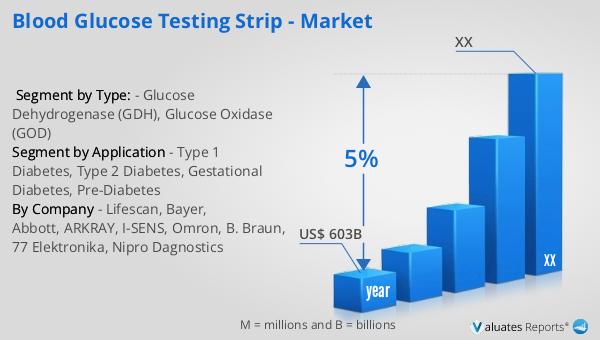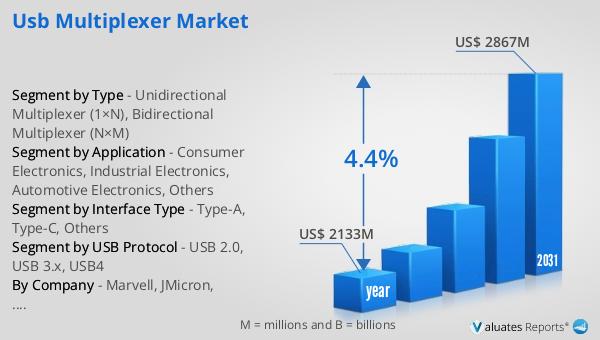What is Blood Glucose Testing Strip - Global Market?
Blood glucose testing strips are small, disposable strips used in conjunction with blood glucose meters to monitor blood sugar levels. These strips are a crucial component in managing diabetes, a condition characterized by high blood sugar levels. The global market for blood glucose testing strips is driven by the increasing prevalence of diabetes worldwide, advancements in technology, and the growing awareness of diabetes management. These strips work by using a small drop of blood, usually obtained from a fingertip, which is then placed on the strip. The strip is inserted into a glucose meter, which reads the blood sugar level and displays it on a screen. This process allows individuals to monitor their blood sugar levels regularly, helping them manage their condition more effectively. The market is also influenced by the rising demand for home healthcare devices, as more people prefer to manage their health conditions at home. Additionally, the development of more accurate and user-friendly testing strips has contributed to the market's growth. The global market for blood glucose testing strips is expected to continue expanding as the prevalence of diabetes increases and more people become aware of the importance of regular blood sugar monitoring.

Glucose Dehydrogenase (GDH), Glucose Oxidase (GOD) in the Blood Glucose Testing Strip - Global Market:
Glucose Dehydrogenase (GDH) and Glucose Oxidase (GOD) are two enzymes commonly used in blood glucose testing strips. These enzymes play a crucial role in the biochemical reaction that occurs when a blood sample is applied to the strip. GDH-based strips use the enzyme glucose dehydrogenase, which catalyzes the oxidation of glucose in the blood sample. This reaction produces an electrical current proportional to the glucose concentration, which is then measured by the glucose meter. GDH-based strips are known for their high accuracy and are less affected by the presence of other sugars in the blood, making them a popular choice for many users. On the other hand, GOD-based strips use the enzyme glucose oxidase, which also catalyzes the oxidation of glucose. However, this reaction involves the conversion of glucose to gluconic acid and hydrogen peroxide. The hydrogen peroxide is then broken down, producing an electrical signal that is measured by the glucose meter. GOD-based strips are widely used due to their reliability and cost-effectiveness. However, they can be affected by the presence of other substances in the blood, such as oxygen and certain medications, which can interfere with the accuracy of the results. Both GDH and GOD-based strips have their advantages and disadvantages, and the choice between them often depends on the specific needs and preferences of the user. The global market for blood glucose testing strips is influenced by the demand for both types of strips, as they cater to different segments of the diabetic population. As technology continues to advance, new and improved testing strips are being developed, offering greater accuracy, ease of use, and convenience for users. The competition between GDH and GOD-based strips drives innovation in the market, leading to the development of more sophisticated and reliable products. This ongoing innovation is essential in meeting the growing demand for effective diabetes management solutions. The global market for blood glucose testing strips is expected to continue evolving as new technologies emerge and more people become aware of the importance of regular blood sugar monitoring. As the prevalence of diabetes continues to rise, the demand for accurate and reliable testing strips will only increase, driving further growth in the market.
Type 1 Diabetes, Type 2 Diabetes, Gestational Diabetes, Pre-Diabetes in the Blood Glucose Testing Strip - Global Market:
Blood glucose testing strips are essential tools for managing various types of diabetes, including Type 1, Type 2, gestational diabetes, and pre-diabetes. In Type 1 diabetes, the body's immune system attacks and destroys insulin-producing cells in the pancreas, leading to high blood sugar levels. People with Type 1 diabetes need to monitor their blood sugar levels regularly to manage their condition effectively. Blood glucose testing strips allow them to check their blood sugar levels multiple times a day, helping them adjust their insulin doses and maintain stable blood sugar levels. In Type 2 diabetes, the body becomes resistant to insulin or doesn't produce enough insulin, leading to high blood sugar levels. Blood glucose testing strips are crucial for people with Type 2 diabetes, as they help them monitor their blood sugar levels and make necessary lifestyle changes, such as diet and exercise, to manage their condition. Gestational diabetes occurs during pregnancy when the body cannot produce enough insulin to meet the increased demand. Blood glucose testing strips are vital for pregnant women with gestational diabetes, as they help them monitor their blood sugar levels and ensure a healthy pregnancy. Pre-diabetes is a condition where blood sugar levels are higher than normal but not high enough to be classified as diabetes. People with pre-diabetes can use blood glucose testing strips to monitor their blood sugar levels and make lifestyle changes to prevent the progression to Type 2 diabetes. The global market for blood glucose testing strips is driven by the increasing prevalence of these conditions and the growing awareness of the importance of regular blood sugar monitoring. As more people are diagnosed with diabetes and pre-diabetes, the demand for blood glucose testing strips continues to rise. The market is also influenced by advancements in technology, which have led to the development of more accurate and user-friendly testing strips. These advancements have made it easier for people to monitor their blood sugar levels at home, contributing to the market's growth. The global market for blood glucose testing strips is expected to continue expanding as the prevalence of diabetes and pre-diabetes increases and more people become aware of the importance of regular blood sugar monitoring.
Blood Glucose Testing Strip - Global Market Outlook:
Based on our research, the global market for medical devices is projected to reach approximately $603 billion in 2023. This market is anticipated to grow at a compound annual growth rate (CAGR) of 5% over the next six years. This growth is driven by several factors, including the increasing prevalence of chronic diseases, advancements in medical technology, and the growing demand for home healthcare devices. The medical device market encompasses a wide range of products, including diagnostic equipment, surgical instruments, and monitoring devices, among others. The rising demand for innovative and efficient medical devices is expected to drive market growth, as healthcare providers and patients seek more effective solutions for managing health conditions. Additionally, the aging population and the increasing focus on preventive healthcare are contributing to the market's expansion. As the global healthcare landscape continues to evolve, the demand for advanced medical devices is expected to rise, driving further growth in the market. The medical device market is also influenced by regulatory changes and the increasing emphasis on patient safety and quality of care. As a result, manufacturers are investing in research and development to create more sophisticated and reliable products that meet the evolving needs of healthcare providers and patients. The global market for medical devices is expected to continue growing as new technologies emerge and more people become aware of the importance of regular health monitoring and management.
| Report Metric | Details |
| Report Name | Blood Glucose Testing Strip - Market |
| Accounted market size in year | US$ 603 billion |
| CAGR | 5% |
| Base Year | year |
| Segment by Type: |
|
| Segment by Application |
|
| By Region |
|
| By Company | Lifescan, Bayer, Abbott, ARKRAY, I-SENS, Omron, B. Braun, 77 Elektronika, Nipro Dagnostics |
| Forecast units | USD million in value |
| Report coverage | Revenue and volume forecast, company share, competitive landscape, growth factors and trends |
